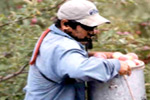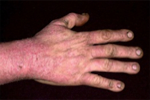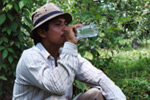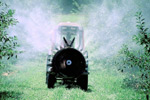Common Farmworker Health Conditions and Diagnostic Tools
Diagnostic Tools
A. WHACS – Simple mnemonic device for taking a farmworker occupational health history
What do you do?
- Tell me exactly what you have been doing on your job. For how long?
How do you do it?
- Are there awkward postures? Heavy loads? Repetitive motions?
- What kinds of tools do you use?
- How many hours do you usually work each day?
- Do you have any days off?
- Other possible hazards/protections to ask about:
- heat, cold, chemicals (pesticides and others), fumes, insects, ultraviolet light
- dusts and natural plant materials
- protective eyewear, hearing protection, long sleeves, pants
- boots, gloves
- dust mask, respirator
- shields on machinery, roll-bars on tractors, lighting, anti-slip surfaces
- rest-breaks, stretching
- water, bathrooms
Are you near any dangerous or bothersome things on the farm?
- Did you have skin contact with any chemicals or plant materials that were irritating?
- Did you breathe any chemicals or dusts that bothered you?
- Can you wash hands before eating or smoking?
Co-workers or others with similar problems?
Satisfied with your job?
- Are you having problems with your boss or crew chief?
- Do you get along with your co-workers?
- Are there problems with your housing?
- Are there problems at home?
WHAT DOES THE “WHACS” REVEAL?
If these suggest a possible occupational problem, explore a little further. Here are some further probes that may be useful:
- Can you tell me more about [the job and health condition]?
- Do you have any thoughts about why this has happened to you?
- Have you tried anything that might help you? Can you tell me more about that?
It may also be helpful to go to the WORKSITE VISIT portion of the website. Find the most similar crop/commodity listed. Show the video to the farmworker. Ask:
- Is this similar to what you do? How is it different?
- Do you have pain/discomfort during this activity?
- Can you tell me more about that?
- Are there other parts of your job you would like to talk about?
The occupational history is most useful if:
-You do it.
-You proceed gradually enough to allow accurate recollection and reporting.
-You ask further about any work exposures that you do not understand clearly.
-You gain a clear idea of how the work is being done.
For more information, see: Recognizing Occupational Disease — Taking an Effective Occupational History, by M. Lax and colleagues.
For occupational health clinics across the U.S., and other educational resources, see: Association of Occupational and Environmental Clinics.
Common Farmworker Health Conditions
- Arcury TA, Feldman SR, Schulz MR, Vallejos Q, Verma A, Fleischer AB, Jr, Rapp SR, Davis SF, Preisser JS, Quandt SA. Diagnosed skin diseases among migrant farmworkers in North Carolina: Prevalence and risk factors. J Agric Saf Health. 2007;13:407–418.
- Brumitt, J., Reisch, R., Krasnoselsky, K., Welch, A., Rutt, R., Garside, L. I., & McKay, C. (2011). Self-reported musculoskeletal pain in Latino vineyard workers. Journal of Agromedicine, 16, 72-80.
- Fathallah FA, Musculoskeletal disorders in labor-intensive agriculture. Ergonomics (2010) Volume: 41, Issue: 6, Publisher: Elsevier Ltd, Pages: 738. http://www.mendeley.com/research/musculoskeletal-disorders-laborintensive-agriculture/
- Faucett J, Meyers J, Tejeda D, Janowitz I, Miles J, Kabashima J. An instrument to measure musculoskeletal symptoms among immigrant Hispanic farmworkers: validation in the nursery industry. J Agric Saf Health. 2001 Aug;7(3):185-98
- Feldman SR, Vallejos QM, Quandt SA, Fleischer AB Jr, Schulz MR, Verma A, Arcury TA. Health care utilization among migrant Latino farmworkers: the case of skin disease. J Rural Health. 2009 Winter;25(1):98-103. Available online at: http://www.ncbi.nlm.nih.gov/pmc/articles/PMC2737349/pdf/nihms114780.pdf
- Heffess, A, Musculoskeletal Complaints in a Population of Migrant Farmworkers in Rural Delaware Date Published: 199? http://www.ncfh.org/pdfs/4082.pdf
- Jackson LL, Rosenberg HR Preventing heat-related illness among agricultural workers. J Agromedicine. 2010 Jul;15(3):200-15. http://www.ncbi.nlm.nih.gov/pubmed/20665306
- Kirkhorn S, Earle-Richardson G, Repetitive Motion Injuries, in Agricultural Medicine, A Practical Guide, J. Lessinger, Editor, 2005. Springer. Pp 324-338.
- Kirkhorn S, Greenlee RT, Reeser JC Epidemiology of agriculture-related osteoarthritis and its impact on occupational disability. WMJ. 2003;102(7):38-44. http://www.wisconsinmedicalsociety.org/_WMS/publications/wmj/issues/wmj_v102n7/Kirkhorn.pdf
- Kirkhorn SR, Earle-Richardson G, Banks RJ, Ergonomic Risks and Musculoskeletal Disorders in Production Agriculture: Recommendations for Effective Research to Practice. Journal of Agromedicine. 2001 Volume 15, Issue 3, 2010 pages 281-299.
- Krejci-Manwaring J, Schulz MR, Feldman SR, Vallejos Q, Quandt SA, Rapp SR, Arcury TA. Skin disease among Latino farmworkers in North Carolina. J Agric Saf Health. 2006;12:155–163. [PubMed]
- Meyers JM, Chapman L, Ergonomics and musculoskeletal injuries in agriculture: recognizing and preventing the industry’s most widespread health and safety problem http://nasdonline.org/document/1839/d001771/ergonomics-and-musculoskeletal-injuries-in-agriculture.html
- Mirabelli MC, Quandt SA, Crain R, Grzywacz JG, Robinson EN, Vallejos QM, Arcury TA. Symptoms of heat illness among Latino farm workers in North Carolina. Am J Prev Med. 2010 Nov;39(5):468-71.
- Simcox N, Flanagan ME, Camp J, Spielholz P, Snyder K, Musculoskeletal risks in washington state apple packing companies, Univ. Washington Dept. Environmental Health, Seattle http://nasdonline.org/static_content/documents/1928/d001835.pdf
 Muscle Strain
Muscle Strain
 Skin Conditions
Skin Conditions
 Eye Conditions
Eye Conditions
 Falls and Other Traumatic Injury
Falls and Other Traumatic Injury
 Heat and Cold Exposure
Heat and Cold Exposure
 Chemical Contact
Chemical Contact